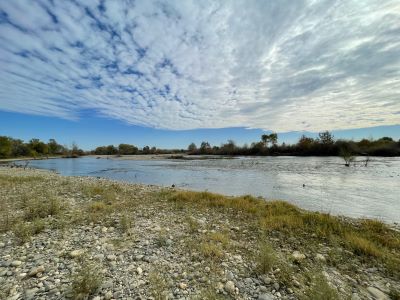Multiyear project rejuvenates key stretch of salmon and steelhead habitat
 An upstream view of the Yuba River
An upstream view of the Yuba River
A degraded stretch of the Yuba River in Northern California is now a haven for migrating fish thanks to a major restoration project supported by Central Valley Project Improvement Act funding.
Launched in 2019, the Hallwood Side Channel and Floodplain Restoration Project, is impressive in its breadth, creating more than 150 acres of seasonally inundated riparian floodplain, about 2 miles of perennial side channels, and about 6 miles of seasonally inundated side channels, alcoves, and swales.
Reclamation provided about $4.25 million to the project, which was administered by the U.S. Fish and Wildlife Service.
“Reclamation and the Service are proud to partner on this very large restoration project,” said David Mooney, manager of Reclamation’s Bay-Delta Office. “The Yuba River can be a large producer of Chinook salmon and this project is a big step in restoring runs of Chinook salmon, steelhead and other fish.”
Hallwood’s goals are simple: make a reach of the Yuba River “a more natural and fishier place for a thriving self-sustaining river ecosystem,” said Chris Hammersmark, ecohydrologist and director at cbec eco engineering, which helped orchestrate the complex and comprehensive restoration project.
“We needed to help the river by removing the unnatural constraints on its natural dynamism to allow it to inundate its floodplain during wet periods, provide rearing habitat for juvenile salmon and adjust the location of its channels, providing an ever-evolving mosaic of aquatic and terrestrial habitat types,” he said.
For decades, the Yuba River has flowed in a disjointed and disconnected manner, the legacy of the exhaustive, ecosystem-altering dredge mining for gold that occurred during the end 19th century. The wholesale displacement of the river’s banks and channel washed downstream a pile of debris dozens of feet high. The river’s natural floodplain was disrupted as “training walls” were constructed to channel water quickly through the area.

When we think about what happened to this landscape during that brief 20- to 25-year period when hydraulic mining occurred it’s pretty remarkable,” said Aaron Zettler-Mann, executive director of the South Yuba River Citizens League. “That legacy of hydraulic mining debris means that today the river is largely disconnected from its floodplain so that means that as flows increase there’s nowhere for juvenile salmon to go and hide from the swift water.”
All the work completed at Hallwood is founded on providing significant and positive long-term impacts on anadromous fish production in the Yuba, Feather, and lower Sacramento rivers. Improving natural reproduction conditions for anadromous fish such as Chinook salmon is one of the core tenets of the Central Valley Project Improvement Act.
The transformation at Hallwood was done through a herculean effort that literally moved mountains of dredger tailings as work crews relocated and processed millions of cubic yards of gravel and debris. In a fortuitous development, the adjacent Teichert Construction company hauled the rock away for processing for local road projects, saving more than $90 million in costs.
Paul Cadrett, fish biologist with the U.S. Fish and Wildlife Service, said Hallwood’s many design features provide “much needed” juvenile fish habitat in the Yuba River.

“These habitat features are designed to increase primary productivity, which become food for juvenile salmon and steelhead,” he said. “This also allows juvenile fish to get out of the main flow of the river and eat and grow prior to migrating downstream to the ocean.”
The success seen at Hallwood bodes well for future projects, said Hammersmark.
“We already are learning much from the project’s monitoring program, knowledge that will be used to support the further rehabilitation of the Yuba River and other degraded rivers,” he said.
In addition to the Central Valley Project Improvement Act, California Propositions 1, 68 and Yuba Water Agency funded the project. Project partners included U.S. Fish and Wildlife Service, California Natural Resources Agency, cbec eco engineering, Cramer Fish Sciences, South Yuba River Citizens League, Wildlife Conservation Board, Yuba Water Agency and Teichert Construction.


